Gračanica, Bosnia and Herzegovina
Gračanica
Грачаница | |
|---|---|
| Grad Gračanica Град Грачаница City of Gračanica | |
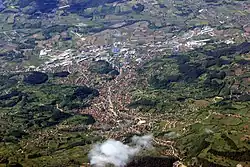 | |
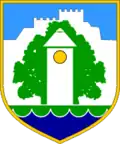 Coat of arms | |
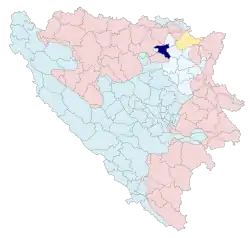 Location of Gračanica within Bosnia and Herzegovina. | |
| Coordinates: 44°41′21″N 18°18′08″E / 44.68917°N 18.30222°E | |
| Country | |
| Entity | Federation of Bosnia and Herzegovina |
| Canton | |
| Government | |
| • Mayor | Sadmir Džebo (SDA) |
| Area | |
• City | 216 km2 (83 sq mi) |
| Population (2013 census) | |
• City | 45,220 |
| • Density | 210/km2 (540/sq mi) |
| • Urban | 13,400 |
| Time zone | UTC+1 (CET) |
| • Summer (DST) | UTC+2 (CEST) |
| Postal code | 75276 |
| Area code | +387 35 |
| Website | www |
Gračanica (Cyrillic: Грачаница) is a city located in Tuzla Canton of the Federation of Bosnia and Herzegovina, an entity of Bosnia and Herzegovina. It is one of the most developed cities in Bosnia and Herzegovina.[1][2]
History
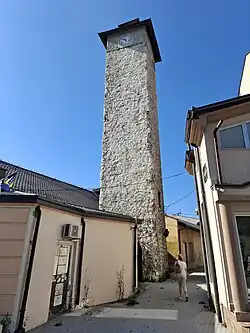
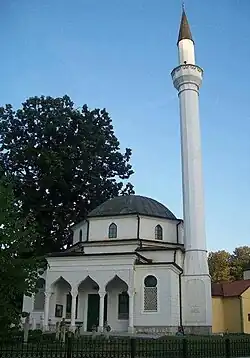
Gračanica is located in northeastern Bosnia and Herzegovina, east of Doboj and west of Tuzla. As of 2013, it has a population of 45,220 inhabitants. It is located in the lower valley of the River Sokoluša along the main road from Tuzla to Doboj, about 50 km west of Tuzla.
The earliest documented references to Gračanica date back to 1528 in Ottoman archives, where it was identified for its iron mine. Approximately 4 km (2.5 mi) from the town, a medieval fortress named Sokol existed. Gračanica attained town status in 1548. During the 17th century, it underwent expansion facilitated by Ahmed-paša Budimlija, who constructed the White Mosque, a public bath, and a clock tower. Under the Austrian Empire, Gračanica witnessed substantial economic, urban, and cultural advancements. At the beginning of the 20th century, there were 11 mosques, an Orthodox and a Catholic church and a Jewish temple (synagogue) in Gračanica, which testifies to the multi-ethnicity and multi-confessional nature of this city.[3]
From 1929 to 1941, Gračanica was part of the Vrbas Banovina within the Kingdom of Yugoslavia.[4][3] Today is part of the Tuzla Canton n the Federation of Bosnia and Herzegovina, an entity of the Bosnia and Herzegovina.
The local football club is Bratstvo that plays in the first League of the Federation of Bosnia and Herzegovina. Hanball Club Gračanica is a handball club from the Gračanica that competes in the National Championship of Bosnia and Herzegovina.
Climate
In January, the average temperature is 1.8 °C (35.2 °F), while in July, it rises to 23.3 °C (73.9 °F). This region is known for its limited precipitation, with an annual average of 830mm/m2. The highest precipitation occurs in May (121mm) and June (101mm), while March records the lowest (41mm). Snowfall is most frequent in January, February, and March, with an average of 50 days per year. Gračanica exhibits a continental climate type.
Settlements
The City of Gračanica consists of 23 settlements: Babići, Doborovci, Donja Lohinja, Džakule, Gornja Lohinja, Gračanica, Lendići, Lukavica, Malešići, Miričina, Orahovica Donja, Orahovica Gornja, Piskavica, Pribava, Prijeko Brdo, Rašljeva, Skipovac Donji, Skipovac Gornji, Sočkovac, Soko, Stjepan Polje, Škahovica, Vranovići.
Notable people
|
|
Twin towns – sister cities
|
|
Demographics
Ethnic composition
| Ethnic composition | ||||||||
|---|---|---|---|---|---|---|---|---|
| 2013. | 1991. | 1981. | 1971. | 1961. | ||||
| Total | 45,220 (100,0%) | 59,134 (100,0%) | 54,311 (100,0%) | 46,950 (100,0%) | 30,203 (100,0%) | |||
| Bosniaks | 43,857 (96,99%) | 42,599 (72,04%) | 38,189 (70,32%) | 33,135 (70,58%) | 20,726 (68,62%) | |||
| Others | 1,134 (2,508%) | 1,315 (2,224%) | 288 (0,530%) | 219 (0,466%) | 77 (0,250%) | |||
| Serbs | 157 (0,347%) | 13,558 (22,93%) | 13,226 (24,35%) | 13 135 (27,98%) | 8,543 (28,29%) | |||
| Croats | 72 (0,159%) | 132 (0,223%) | 135 (0,249%) | 199 (0,424%) | 171 (0,570%) | |||
| Yugoslavs | 1,530 (2,587%) | 2,359 (4,344%) | 184 (0,392%) | 686 (2,270%) | ||||
| Montenegrins | 50 (0,092%) | 45 (0,096%) | ||||||
| Roma | 24 (0,044%) | 1 (0,002%) | ||||||
| Albanians | 20 (0,037%) | 10 (0,021%) | ||||||
| Macedonians | 13 (0,024%) | 9 (0,019%) | ||||||
| Slovenes | 5 (0,009%) | 7 (0,015%) | ||||||
| Hungarians | 2 (0,004%) | 6 (0,013%) | ||||||
Gallery
-
 Hasan Kikić Elementary School, Gračanica
Hasan Kikić Elementary School, Gračanica -
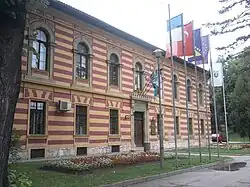 City Hall of the City of Gračanica
City Hall of the City of Gračanica -
Downtown of Gračanica
-
_z_18._stol.jpg) Madrasa of Osman-kapetan in Gračanica
Madrasa of Osman-kapetan in Gračanica
References
- ^ "Opština Gračanica među dvadeset najrazvijenijih opština u Bosni i Hercegovini". gracanica.gov.ba. 30 August 2023. Retrieved 2023-08-30.
- ^ "Zašto je Gračanica lider u biznisu". lokal.ba. 30 August 2023. Retrieved 2023-08-30.
- ^ a b "O Gračanici". Visit Gračanica. 30 August 2023. Retrieved 2023-08-30.
- ^ "Historija grada Gračanica". gracanica.gov.ba. 30 August 2023. Retrieved 2023-08-30.
- ^ "Grad (Menu) → Bratimljeni gradovi". gracanica.gov.ba (in Bosnian). Gračanica. Retrieved 2019-12-23.
Literature
- Official results from the book: Ethnic composition of Bosnia-Herzegovina population, by municipalities and settlements, 1991. census, Zavod za statistiku Bosne i Hercegovine - Bilten no.234, Sarajevo 1991.
